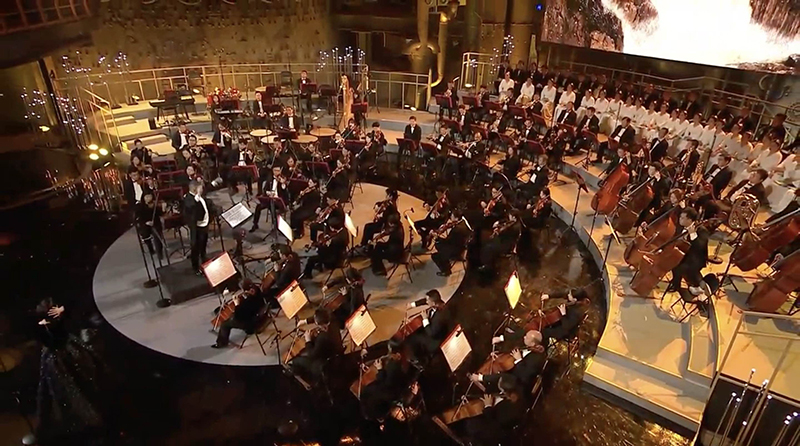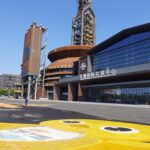Blast furnace concert venue.
On the evening of October 11th, the 2025 Beijing Xishan Yongding River Cultural Festival opened at Shougang Park.
This cultural festival adopts the theme «Eternal Mountains and Rivers, Peaceful Homeland» and follows a «1+4+N» activity model, consisting of one opening ceremony, four key activities, and multiple themed events along the Xishan Yongding River Cultural Belt.
On October 11th, the opening ceremony of this cultural festival was held at Shougang Park in Shijingshan District. The event combined a launch ceremony, blast furnace concert performances, and immersive market experiences across multiple districts to showcase the innovative vitality of the Xishan Yongding River Cultural Belt.
The launch ceremony connected tourism promotion videos from various districts, highlighting the vibrant autumn colors of Xishan and the winding flow of Yongding River, demonstrating the unique cultural ecology where «each district shines in its own way, creating beauty together.»
The blast furnace concert has become the «golden name card» of the Xishan Yongding River Cultural Festival, having been held for four consecutive years. The 2025 blast furnace concert once again delivered a spectacular performance, structured around the theme «Eternal Mountains and Rivers, Peaceful Homeland» with two epic chapters: «Red Memories» and «Colorful Future.» Through music, it connected the inheritance of national spirit with the pulse of contemporary development. The concert achieved multiple breakthroughs in artistic presentation and technical application, revitalizing industrial heritage with new energy. In terms of spatial reconstruction, it fully utilized the steel structure of No. 3 Blast Furnace, transforming it into a «breathing stage» — through lighting projection technology, the blast furnace itself became a «narrative medium,» allowing audiences to immerse themselves in a dialogue between history and modernity through sound and light.
That afternoon, the south square of Shougang Park’s No. 3 Blast Furnace transformed into the «Xishan Yongding River Cultural Market,» launching a 120-minute immersive tourism promotion livestream. Visitors could personally experience intangible cultural heritage crafts, sample local delicacies, and take photos with cultural landmark models, discovering the diverse charm of the Xishan Yongding River Cultural Belt through «browsing, appreciating, playing, and shopping.» This «one main stage promotion + multi-district cultural markets» model broke down regional barriers, turning cultural resources from «static displays» into «dynamic interactions,» building bridges for cross-district visitor flow and route connections, and supporting the deeper development of Beijing’s comprehensive tourism.
As one of the key activities of this cultural festival, Shijingshan District plans to hold the opening ceremony of Shijingshan Academy during the festival period. The academy will build upon the historical foundation of the Xishan Yongding River Cultural Belt, with the mission of «preserving cultural heritage and nurturing the soul,» creating a cultural space that integrates book collections, academic research, cultural exchanges, and public reading, injecting «literary energy» into the inheritance and innovation of the Xishan Yongding River Cultural Belt.
Daxing District is hosting the «Xishan Yongding River Cultural Belt Public Cultural Season» during the festival, including the «New Daxing, New National Gateway, New Image» photography exhibition and the «Peak of Xishan, Glory of Yongding» themed calligraphy and painting exhibition, extensively exploring and promoting the historical and cultural significance of Yongding River and the ecological changes and tourism appeal of the Xishan Yongding River area.
On the day of the cultural festival opening ceremony, Shijingshan District Federation of Literary and Art Circles, together with the District Propaganda Department and Cultural Tourism Bureau, organized the «Yongding River Impressions» calligraphy, painting, and photography exhibition. This exhibition uses calligraphy, painting, and photography as artistic mediums, capturing natural scenery throughout the changing seasons to vividly showcase the unique charm and profound heritage of the Xishan Yongding River Cultural Belt, further enhancing the influence of the «Eternal Mountains and Rivers» cultural brand and supporting the preservation and development of cultural heritage in the new era.
During the 2025 Beijing Xishan Yongding River Cultural Festival, cultural belt member units and districts along the route are organizing various themed activities, such as the Beijing Municipal Forestry and Parks Bureau’s «Beijing Xishan Zero-Carbon Forest Concert,» Haidian District’s «Bei Family Garden Exhibition» and «Zhongguancun Dance Drama Show,» Shijingshan District’s Moshikou New Book Live Sharing Session, Fangshan District



